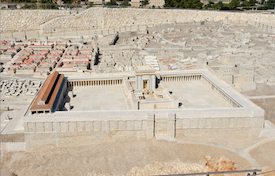 Both God and men play a role in the production of Scripture. We speak of that factor as the confluent nature of Scripture. Such confluency allows for the human authors to differ in vocabulary, phraseology, literary style, and purposes. God chose each writer for the purpose and means He had in mind. Differences in the authors’ choices do not come as any surprise to the Spirit of God who carried them along according to God’s own plan (2 Peter 1:21).
Both God and men play a role in the production of Scripture. We speak of that factor as the confluent nature of Scripture. Such confluency allows for the human authors to differ in vocabulary, phraseology, literary style, and purposes. God chose each writer for the purpose and means He had in mind. Differences in the authors’ choices do not come as any surprise to the Spirit of God who carried them along according to God’s own plan (2 Peter 1:21).
In Matthew’s and Luke’s accounts of the temptation of Jesus we note a difference in the order of the three temptations. In Matthew 4:1–10 the order is
- Turning stones to bread due to being hungry (vv. 1–4)
- Throwing Himself off the pinnacle of the Temple to test God’s care (vv. 5–7)
- Tempted to worship Satan to gain all the world’s kingdoms (vv. 8–10)
In Luke 4:1–12, however, the order is
- Turning stones to bread due to being hungry (vv. 1–4)
- Tempted to worship Satan to gain all the world’s kingdoms (vv. 5–8)
- Throwing Himself off the pinnacle of the Temple to test God’s care (vv. 9–12)

Why the difference between the two Gospels? Is one in error? First, note that both Gospels attest to the fact that Satan tempted Jesus. Second, both Gospels describe the same three temptations. Third, both Gospels record the same responses Jesus gives to each situation. Therefore, the difference is not one of substance, but of arrangement. In Matthew’s Gospel verse 4 begins with “Then” and verse 8 begins with “Again.” These indicate a chronological sequence of events. Luke’s Gospel, however, uses only “And” to connect the temptations. Therefore, it is probably best that we understand that Matthew records the chronological arrangement of the temptations, while Luke orders them topically. Luke’s purpose in his arrangement of the events might have been in order to focus on the potential death of Jesus that might have occurred had He actually jumped from the pinnacle of the Temple or to focus on Jerusalem, when he does repeatedly in his Gospel (Luke 2:49; 9:51; 13:32–35; 19:45–46; 24:53). Also, his Gospel opens (Luke 1:9) and closes (Luke 24:53) with scenes of worship in the Temple. In either case, the Holy Spirit superintended each Gospel writer to produce a Gospel with its own style and tone without resulting in a false or inaccurate witness.
Read also: “The Synoptic Gospels’ Inerrancy: Geographical Realities” and “The Synoptic Gospels’ Inerrancy: Translation Differences”
